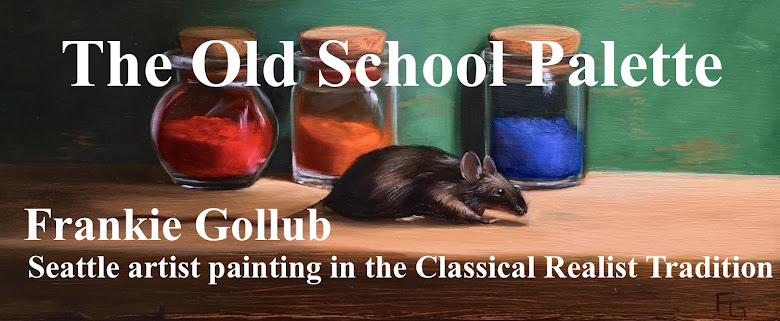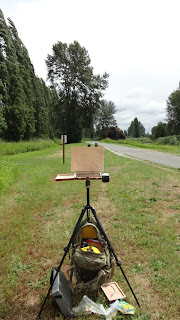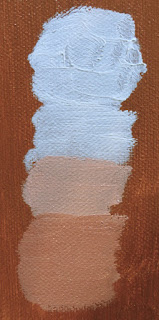Sunday June 19, Discovery Park in Seattle, WA
I made a trip back to discovery park and it is a place that has many good spots for plein air painting. I walked around for about an hour before I decided to paint the same view I had done in watercolors a week earlier. It was a cool sunny day with clouds over the Olympic Mountains.
I had set up my cigar pochade box for oil painting. I made a palette using a masonite panel, two side trays (only one shown), and hooks for a jar of Walnut oil.
I do not use solvent in my painting technique, nor to clean my brushes. I use Walnut oil for cleaning brushes while I'm painting then vegetable oil followed by soap and water at the end of painting session. I found that cleaning brushes like this extends their life. Brushes that I've had for over a year are still holding up. Then again they are Rosemary Brushes and their longevity may be based on their superb quality.
The panel I used is a 9 x 12 Raymar 1/16" Feather Lite Panel, Claessens #15 Double Oil Primed. Over the past year I have only used Alluminum Composite Panels which I prime myself. For plein air painting I decided to try the Raymar panels and I bought several sample packs.
To carry my equipment I am using a Spec Ops T.H.E. Pack which I've had for almost four years. I use this pack for hiking. I was in the Army National Guard for 6 years and I prefer military style gear. I chose this pack over my Eddie Bauer pack because I can strap the tripod to the side. New equipment also includes a Raymar Panel carrier which can hold 10 x 12 and 9 x 12 panels. I decided to stick with this size for plein air painting in oils. The Raymar Panel carrier is lightweight and is more practical than the heavier wood carriers on the market. Though it has a shoulder strap, I secured it to my pack with bungee cords. The shoulder strap is looped over my pack's top pouch and secured with the upper cinching straps.
I painted for about two hours, starting my painting with a sketch in Roman Black Earth, followed by blocking in the darks and lights. The medium I used was Venetian Medium. The masonite palette I was using was not fully conditioned and it kept sucking the oil out of my paints. This was a real pain and I was not able to complete more of the painting than I had aimed for. At the end of the session this is what I had. I decided to complete the rest at home.
Discovery Park, Seattle, WA, Oil on linen on MDF Panel, 9 x12
Several days later I completed the painting in the studio using photos I had taken. Yes, I know this goes against what plein air painting is all about. Most plein air painters use a loose impressionistic style but that's not where I want to go with my work. My own work is tight and can be meticulous. The landscape painters I admire most are of the Hudson River School along with modern masters like Erik Koeppel.
Thursday June 23, Woodinville, WA
Thursday was mostly cloudy with rain coming in the afternoon. I decided to head back to Woodinville before the rain started. I wanted to paint the trees along the Sammamish River Trail as I had done on Memorial Day. This time I walked south on the trail to check it out but decided to head back north. In the future I do plan on painting a group of trees on the southern part of the trail.
I had managed to complete my sketch and blocking in of the darks. After that I started the sky and it began to rain. After painting a few minutes it looked like the rain wasn't letting up. It wasn't heavy, nor was it a misty rain. As the rain beaded up on my panel and palette I decided to head back to my vehicle. I figured that I would come back another day even though the rain only lasted 15 minutes.
When I returned home I decided I would use a photo I had taken and complete the painting. That went against my goal of painting outdoors but at least I had started the paint en plein air. This is different than the painting at Discovery Park. Even I though I completed the Discovery Park painting at home using a photo, I remembered enough about what I observed to counteract the flatness of the photo. This included remembering colors and details such as meadows that were visible on some of the closest of the Olympic Mountains. My photo was not able to show such nuances.
Sammamish River Trail, Woodinville, WA- Work in progress
I'm almost done with this painting. I plan to darken and warm up a few areas in the trees and make the tall grass along the river stand out against the vegetation behind it. A drawback to using photos vs. observing the scene from life is that photos are flat and lack the subtleties of light in the shadows. Often the exposure is either too light or too dark.
Within a week I will post my experiences of my first hike to do plein air painting in Washington's Cascade Range.






























